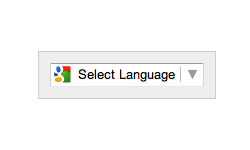rosetta
An alternative to Google Translate’s Website Translator widget that can work with any HTTP backend.
Demo
Here are some example pages:
- Sample 1: https://au5ton.github.io/rosetta/dist/sample.html
- Sample 2: https://au5ton.github.io/rosetta/dist/constitution.html
Premise
On December 4, 2019 Google discontinued its popular Google Translate Widget. The widget can no longer be added to new sites. It is currently still available for websites that already have it installed.

Technically, their widget stills works if you have the code for it, but there’s no telling when it will stop working. As of June 23, 2021, their embeddable snippet is still working, even though the widget was discontinued in 2019.
History
-
Page prior to being discontinued:
https://web.archive.org/web/20180801033735/https://translate.google.com/manager/website/
-
Current page:
-
Announcement of temporary support during the COVID-19 pandemic:
https://developers.google.com/search/blog/2020/05/google-translates-website-translator
Goal
The goal of this project is to revive the simple “plug and play” usage of the legacy Google Translate Widget, but to make its functionality future-proof and transferable to other translation API providers.
Features
- Flexible branding with options
attributionImageUrlandlogoImageUrl-
Built-in branding images that follow attribution guidelines
-
- Easy to use interface that is very similar to the original Google Translate widget
- Can limit the number of language options available with option
preferredSupportedLanguages - Translates elements even if they are added to the DOM after the page loads with MutationObserver.
- Translations are cached in memory per page per session
- This will work best if your back-end also caches translations.
-
Progress indicators are shown while translations are in progress
- The last language you selected is saved so the next page you visit after clicking a link automatically translates (per session per origin)
- Bypass translation using the CSS class
.skiptranslateor attributedata-rosetta-skiptranslate="true". Applying these to a parent, means that it applies to its children as well. - Only the elements that are visible in the viewport are translated, detected with IntersectionObserver.
- Configurable “info” and “help” buttons which can display custom text, such as help text or a disclaimer.
Limitations
Back-end not included
The code available in this widget details the UI portion of the widget. However, a separate API server must be implemented and maintained by those who wish to utilitze this widget.
Translation APIs aren’t free, but a sample API server is available for prototyping. I make no guarantees that this API server will remain active. Don’t rely on this API server in production.
Sample API server:
The schema/model that a separate API server must implement is detailed below.
Browser support
Only ES6 (ECMAScript 2015) is supported. This is because esbuild support for ES5 is only partial. To see which browsers this affects, see caniuse.com/es6. In our TypeScript codebase, we utilize core-js and whatwg-fetch to polyfill newer JavaScript features to older browsers. However, not all of the other features we take advantage of are IE11 compatible. sessionStorage and MutationObserver are IE11 compatible, but IntersectionObserver is not. There is nothing we can do about this.
Usage
Front-end
For a complete list of options and what they do, see options.ts. Their default values can be seen as they are initialized in widget.tsx.
<!-- Whereever you want the widget to appear -->
<div id="translate_widget_element"></div>
<!-- ... -->
<!-- Somewhere in your <body> -->
<script type="text/javascript">
function widgetTranslateElementInit() {
au5ton.translateWidget({
pageLanguage: 'en',
chunkSize: 10,
// For Microsoft Translator API
// attributionImageUrl: 'https://cdn.jsdelivr.net/gh/au5ton/rosetta@0.5.1/dist/msft-translator.svg',
// For Google Cloud Translation API
attributionImageUrl: 'https://cdn.jsdelivr.net/gh/au5ton/rosetta@0.5.1/dist/google-translate.svg',
// To include a custom logo in the banner
// logoImageUrl: 'https://via.placeholder.com/120x20',
preferredSupportedLanguages: ['en', 'es', 'zh', 'de', 'fr'], // or [] to include everything
// List of CSS classes to ignore when translating
// Example: Ignore Google Place Autocomplete popovers
// ignoreClasses: ['pac-container', 'pac-logo'],
// Add this to hide the translation banner
// showBanner: false,
endpoints: {
supportedLanguages: 'https://rosetta-demo-server.vercel.app/api/v3/supportedLanguages',
translate: 'https://rosetta-demo-server.vercel.app/api/v3/translate'
}
}, 'translate_widget_element');
}
</script>
<script src="https://cdn.jsdelivr.net/gh/au5ton/rosetta@0.5.1/dist/index.js" onload="widgetTranslateElementInit()"></script>
Translate attributes
In addition to visible text, rosetta can also translate attributes in tags, such as title on <img> and so on. The list of attributes can be specified with the includedAttributes option. It defaults to title, placeholder and alt.
Update translations in back-end
The translation UI supports updating the translations in the back-end if an optional updateTranslation endpoint is provided. The idea is that the back-end caches the translations, and so the website maintainer can update these translations. If this updateTranslation endpoint is provided, then by hovering over the translations with the Ctrl key pressed, you will get a button to edit a translation.
There’s more information in This issue.
Back-end
Your own back-end server that implements 2 endpoints with the format detailed in openapi.yaml using the OpenAPI 3.0 spec.
To preview this OpenAPI 3.0 spec, open petstore.swagger.io. At the top right, enter the following URL and press “Explore”:
https://au5ton.github.io/rosetta/openapi.yaml
It should look like this:
